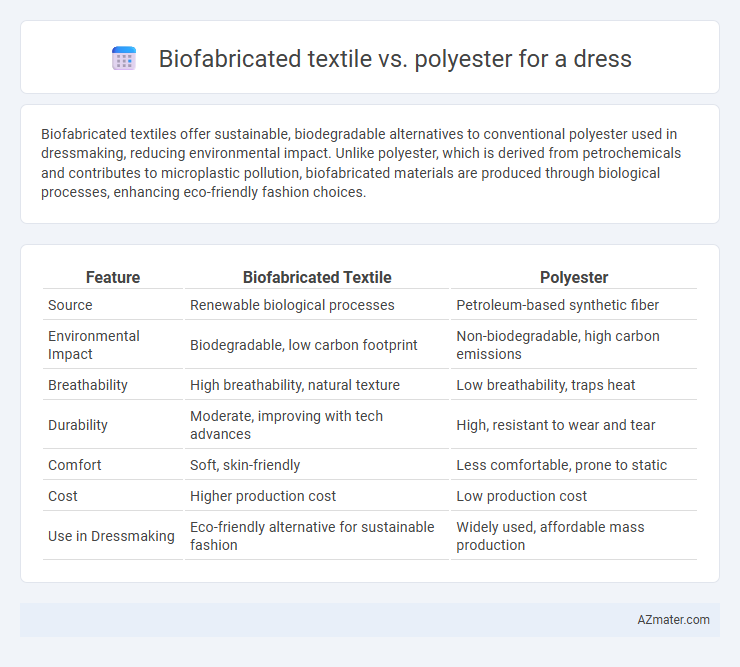Biofabricated textiles offer sustainable, biodegradable alternatives to conventional polyester used in dressmaking, reducing environmental impact. Unlike polyester, which is derived from petrochemicals and contributes to microplastic pollution, biofabricated materials are produced through biological processes, enhancing eco-friendly fashion choices.
Table of Comparison
| Feature | Biofabricated Textile | Polyester |
|---|---|---|
| Source | Renewable biological processes | Petroleum-based synthetic fiber |
| Environmental Impact | Biodegradable, low carbon footprint | Non-biodegradable, high carbon emissions |
| Breathability | High breathability, natural texture | Low breathability, traps heat |
| Durability | Moderate, improving with tech advances | High, resistant to wear and tear |
| Comfort | Soft, skin-friendly | Less comfortable, prone to static |
| Cost | Higher production cost | Low production cost |
| Use in Dressmaking | Eco-friendly alternative for sustainable fashion | Widely used, affordable mass production |
Introduction to Biofabricated Textiles and Polyester
Biofabricated textiles, created through sustainable processes using microorganisms or plant-based materials, offer an eco-friendly alternative to traditional polyester fabrics derived from petrochemicals. Polyester, known for its durability, wrinkle resistance, and cost-effectiveness, dominates the fashion industry but contributes significantly to microplastic pollution and non-biodegradability issues. Biofabricated textiles present innovative possibilities by reducing environmental impact while maintaining comparable strength and versatility for dressmaking.
Material Origins: Biofabrication vs. Synthetic Production
Biofabricated textiles originate from sustainable, renewable biological sources such as microbial fermentation or plant-based materials, offering a reduced environmental impact compared to traditional fabrics. Polyester, a synthetic material derived from petrochemical processes, relies heavily on fossil fuels and involves energy-intensive manufacturing that contributes to greenhouse gas emissions. Choosing biofabricated textiles supports circular economy principles by using biodegradable and renewable resources, contrasting with the non-biodegradable nature of polyester.
Environmental Impact: Comparing Sustainability
Biofabricated textiles significantly reduce environmental impact by utilizing renewable resources and producing minimal waste, contrasting with polyester's reliance on petroleum and high greenhouse gas emissions. The biodegradability of biofabricated materials supports decreased landfill accumulation, whereas polyester contributes to microplastic pollution during washing. Sustainable dress production increasingly favors biofabricated textiles due to their lower carbon footprint and potential for circular lifecycle management.
Performance and Durability in Dresses
Biofabricated textiles demonstrate superior breathability, moisture-wicking, and biodegradability compared to polyester, enhancing comfort and environmental sustainability in dress fabrics. Polyester offers high tensile strength, wrinkle resistance, and color retention, contributing to long-lasting durability and easy maintenance. Dresses made from biofabricated materials prioritize eco-friendly durability with moderate wear resistance, while polyester excels in toughness and prolonged lifespan under frequent use.
Comfort and Breathability: Wearer Experience
Biofabricated textiles offer superior comfort and breathability compared to polyester, as their natural fibers promote better air circulation and moisture absorption. Polyester tends to trap heat and sweat, often causing discomfort and skin irritation during extended wear. Dress materials derived from biofabricated sources provide a softer, cooler feel that enhances overall wearer experience.
Aesthetic Versatility: Design Possibilities
Biofabricated textiles offer unprecedented aesthetic versatility with customizable textures, colors, and patterns, enabling designers to create unique, futuristic dress designs that adapt to wearer preferences or environmental conditions. Polyester, while durable and widely available in numerous colors and finishes, lacks the dynamic design possibilities intrinsic to biofabricated materials, limiting innovation in garment aesthetics. The integration of biofabricated textiles into dressmaking enhances creative freedom, allowing for sustainable, visually striking fashion that traditional polyester cannot match.
Biodegradability and End-of-Life Considerations
Biofabricated textiles offer superior biodegradability compared to polyester, breaking down naturally within months to years without releasing microplastics or toxic residues. Polyester, a synthetic polymer derived from petroleum, can take up to 200 years to decompose and contributes to persistent environmental pollution through microplastic shedding during washing. End-of-life considerations favor biofabricated textiles due to their compatibility with composting and reduced landfill impact, while polyester often ends in incineration or landfills, posing long-term ecological risks.
Cost and Accessibility for Consumers
Biofabricated textiles currently have higher production costs than polyester, making them less affordable for most consumers. Polyester benefits from established manufacturing infrastructure and mass production, driving prices down and increasing accessibility worldwide. As biofabrication technology advances and scales, its cost-efficiency and availability are expected to improve, but polyester remains the dominant choice for budget-conscious dress shoppers today.
Innovations and Future Trends in Textile Manufacturing
Biofabricated textiles leverage cutting-edge biotechnology to create sustainable, biodegradable fabrics using microbial fermentation and cellular agriculture, significantly reducing environmental impact compared to traditional polyester production, which relies on petrochemicals and generates high carbon emissions. Innovations in biofabricated textiles include the development of protein-based fibers mimicking natural materials like silk and leather, alongside advancements in 3D bioprinting and enzymatic processing that promise customizable textures and enhanced durability. Future trends emphasize scaling biofabrication techniques for mass-market adoption, integrating smart textile functionalities, and achieving closed-loop manufacturing to promote circular economy principles in the fashion industry.
Choosing the Right Material: Factors for Dress Selection
Biofabricated textiles offer eco-friendly alternatives with enhanced breathability and biodegradability, making them ideal for sustainable dress choices. Polyester, known for its durability, wrinkle resistance, and moisture-wicking properties, provides long-lasting wear and ease of care. When selecting dress materials, consider environmental impact, comfort, maintenance, and intended use to balance sustainability with performance.

Infographic: Biofabricated textile vs Polyester for Dress
 azmater.com
azmater.com